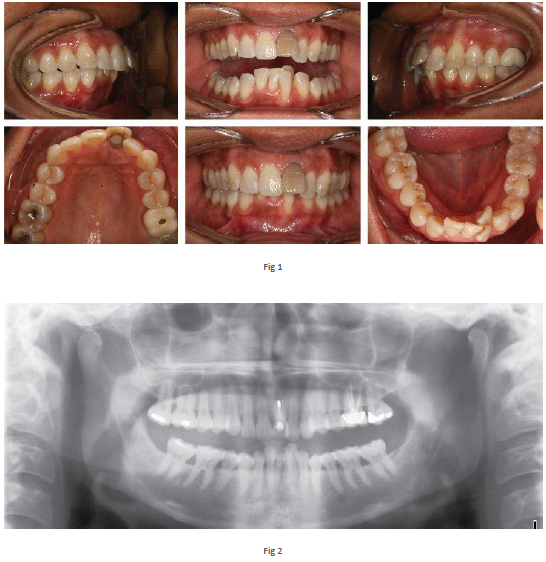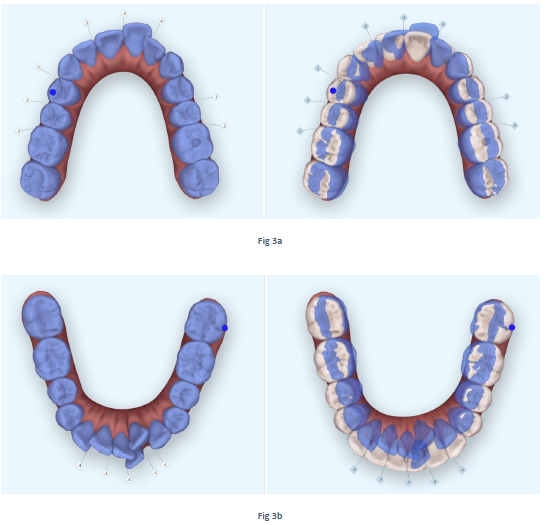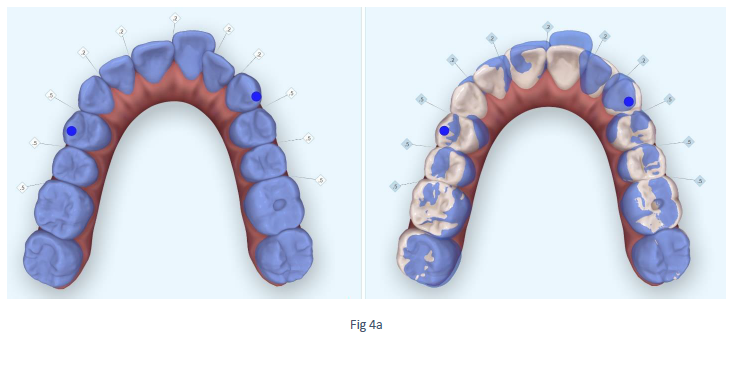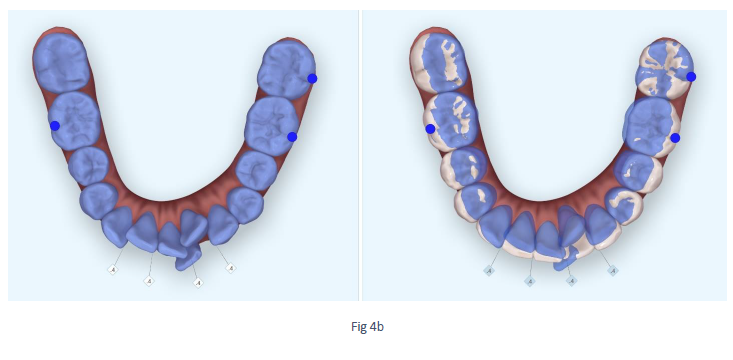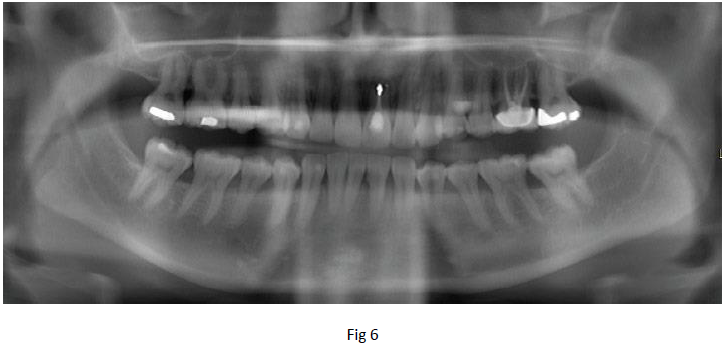Case Study Class II Malocclusion
Case Study: Class II Malocclusion with Deep Bite and Severe Crowding Treated with Invisalign® Clear Aligners. Treatment Plan Optimization by Clear®
Dr. Ann E. Haggard, DDS, Webster, TX
Dr. Adriana Garro-Mena, DMD, MS Orthodontics, Clinical Director, Clear TPS
Case Summary
Invisalign is an excellent option for both adult and non-adult patients as it provides predictable and
stable clinical results. As with other types of orthodontic treatment, careful diagnosis and thorough
treatment planning is important to achieve the most ideal clinical outcome. It is essential that the
ClinCheck® treatment plan is evaluated and modified very carefully when considering tooth
movements and the intra/extra oral tissues to optimize the staging sequence and the amount of
movement planned to achieve the best, moststable results. This case report presents an adult patient
with Class II malocclusion with a deep over bite and severe crowding treated with Invisalign Full where
Clear TPS optimized the ClinCheck treatment plan and a 10% reduction in total treatment time.
Diagnosis and Treatment Planning
A 47-year-old female patient with a chief concern of a “dark front tooth” (UL1) and misaligned teeth.
Clinically, the patient presented a Class II malocclusion with significant lower anterior crowding,
protrusive upper incisors, excessive Curve of Spee, overjet and overbite. At the intraoral examination
we found a dark upper left central incisor with a history of previous endodontics and apicoectomy
treatment (Fig1). Periodontally, the patient had thin biotype and gingival recession of LL1.
Radiographic evaluation showed a Class I skeletal pattern with a lower-than-average mandibular
plane angle and upper and lower incisor inclinations within normal limits. The panoramic radiograph
showed root resorption at the apex of UL1, normal dental development with an absence of third
molars (Fig 2). The patient had good soft tissue support, no significant facial asymmetries, an obtuse
nasal labial angle, asymptomatic TMJ and no parafunctional habits.
Treatment goals included resolving crowding of the maxillary and mandibular arches, correcting the
protrusion of the upper incisors, achieving an optimal overjet and overbite relationship and levelling
the Curve of Spee. The patient was informed that orthodontic movement of UL1 could result in
further root resorption and potential tooth loss and the patient decided to avoid extraction until the
end of orthodontic treatment.
ClinCheck® Treatment Plan
The Invisalign treatment was plan set up initially with expansion, interproximal reduction (IPR) and no extractions. The first ClinCheck treatment plan had 29 upper and lower stages and called for generalized expansion of 2-3mm, significant proclination of the lower anteriors and IPR (Fig 3a and 3b). This initial ClinCheck treatment plan was referred to Clear TPS for optimization of the ClinCheck.
Clear TPS evaluated the case and provided a new optimized ClinCheck treatment plan. During the Clear TPS optimized treatment planning process it was discovered that the proclination planned for the lower incisors was outside the biological limitations. Also, the thin biotype of the gingival tissue as well as the gingival recession of tooth LL1 needed an optimized approach to achieve a more predictable and stable outcome that would take into consideration the long term health of the periodontal tissue.
Clear® Treatment Plan Optimization
One of the biggest advantages of Invisalign as a treatment modality is the ability to use ClinCheck treatment planning software as tool; in this case it allowed the Clear TPS Clinical Experts to explore different expansion and IPR combinations before making a final decision on the need for extractions. This is particularly important for treating doctors and patients who might be considering an extraction option as extractions are often difficult for patients to accept.
The optimized ClinCheck treatment plan developed by Clear TPS after only one week of modifications; this included extraction of LL1 to solve the lower crowding and avoid unhealthy proclination and gingival recession, decreased the overall expansion for better generalized periodontal health, intrusion of lower anteriors to level the Curve of Spee and corrected the deep bite while maximizing posterior IPR to optimize the overjet and improve the canine anterior-posterior relationship (Fig 4a and 4b). Attachments for the space closure at the extraction site were also requested to aid with root parallelism. The approved optimized ClinCheck treatment plan had 26 upper and lower stages. This represents a 10% reduction in total treatment time (3 aligners or 6 weeks of treatment time) which has implications of increased profitability and improved patient experience.
During the course of treatment, tooth UL1 was compromised and lost resulting in a modified treatment goal and plan for placement of a single implant for UL1. Additional aligners were requested to finish the anterior overjet and overbite relationship as a total of 11 upper and lower additional aligners were needed to finish the case.
Results
One of the significant advantages of Clear TPS ClinCheck treatment plan optimization while treating deep bite cases is the ability to begin treatment on both arches simultaneously. After a total treatment time of 18 months, complete correction of all initial treatment goals was achieved without any detrimental effects to the soft tissues (Fig 5). The improvement on the bilateral canine relationship as well as the ideal overjet and overbite accomplished is to be noted. A black triangle persisted interproximal to the extraction spaces which is common in these types of extraction cases. Further IPR to close it was not desired in order to maintain the ideal overjet achieved.
The use of the Invisalign Power Ridge® was successful in maintaining the torque of the upper anterior teeth during alignment, while simultaneously correcting the overbite. Patient compliance was excellent.
This case also demonstrates the ability of Clear TPS treatment plan optimization to level a Curve of Spee with aligners in an adult patient. Curve of Spee Leveling was accomplished via extrusion of the lower buccal segments and intrusion of the lower anterior teeth.
Post-treatment radiographs show improved root parallelism (Fig 6). Incisal inclinations appear similar to the pre-treatment angles, thus showing an effective treatment plan approved in the ClinCheck treatment plan set-up.
Retention was accomplished with a fixed lingual bonded retainer for the maxillary centrals in addition to Vivera retainers on both arches.
Discussion
As the clear aligner market and patient demand continues to increase, the variety and complexity of malocclusions undergoing Invisalign treatment also continues to evolve. Invisalign has invested a significant amount of resources to provide doctors with the necessary tools to achieve more predictable and stable results however, the treatment planning decisions of each treating doctor are essential for successful results and optimal patient-doctor experience.
Clear TPS allows doctors to better identify Invisalign cases to treat and seamlessly assists with the treatment planning process through Clear TPS treatment plan optimization to improve clinical results and to enhance doctor education, reduce ClinCheck modifications, shorten treatment time (in some cases) and increase Invisalign opportunities which ultimately increases the profitability of clear aligner treatments in the practice. This case report is an excellent example of the many benefits that both doctor and patient experience with Clear TPS.
Clinical and Commercial Statistics for Clear TPS Treatment Plan Optimization
• Average rate of case refinement (additional aligners) for doctors using Clear is 4.9%1
• 10-20% reduction of treatment time with Clear® Optimized ClinCheck set up2
• Doctors using Clear experience up to an 85% increase in Invisalign case submissions3
• Over 100,000 clear aligner treatment plans optimized


